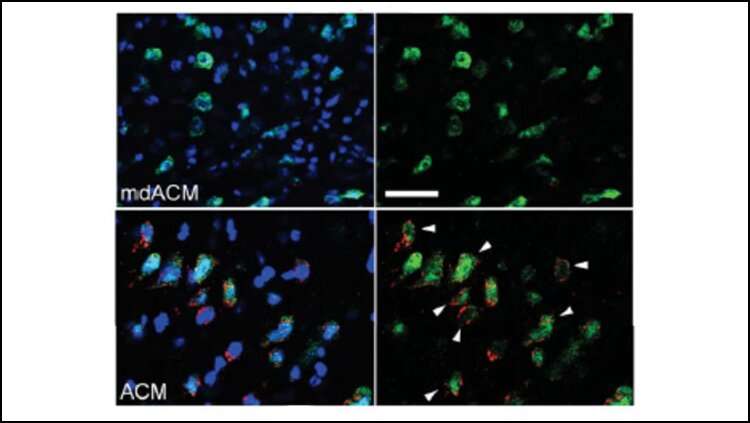Level of Mn-SOD in neurons 21 days after hemmorage in mice that received mitochondria with and without Mn-SOD at one hour, seven days, and 14 days post-hemmorage. White arrows indicate the cells showing high Mn-SOD (red) in the neurons as a result of the treatment. Credit: The Journal of Neuroscience (2022). DOI: 10.1523/JNEUROSCI.2222-21.2022
After a brain hemorrhage, neural support cells called astrocytes enhance healing by transferring their mitochondria to damaged neurons. The healthy mitochondria stimulate the production of a free radical-fighting enzyme, according to new research published in The Journal of Neuroscience.
An artery in the brain bursts. Blood rushes into the tissue, inducing free radicals that cause even more damage. The hemorrhage damages mitochondria, the site of energy production in cells. Astrocytes transfer their mitochondria to damaged neurons after a hemorrhage. These healthy mitochondria contain a "healing" peptide called humanin and an enzyme called manganese superoxide dismutase (Mn-SOD) that help neutralize free radicals.
Tashiro et al. injected mice with healthy mitochondria after a hemorrhage. The hemorrhage reduced levels of Mn-SOD in the mice brain and increased the number of free radicals. Using molecular tags, the researchers found that the rodents' neurons took up the mitochondria from the bloodstream. The mice who received the treatment showed improved neurological recovery, but the benefits decreased if the mice received mitochondria without the Mn-SOD enzyme. These results reveal mitochondria can transfer between brain cells to improve health and aid recovery.
More information: Ryosuke Tashiro et al, Transplantation of astrocytic mitochondria modulates neuronal antioxidant defense and neuroplasticity and promotes functional recovery after intracerebral hemorrhage, The Journal of Neuroscience (2022). DOI: 10.1523/JNEUROSCI.2222-21.2022
Journal information: Journal of Neuroscience
Provided by Society for Neuroscience
























